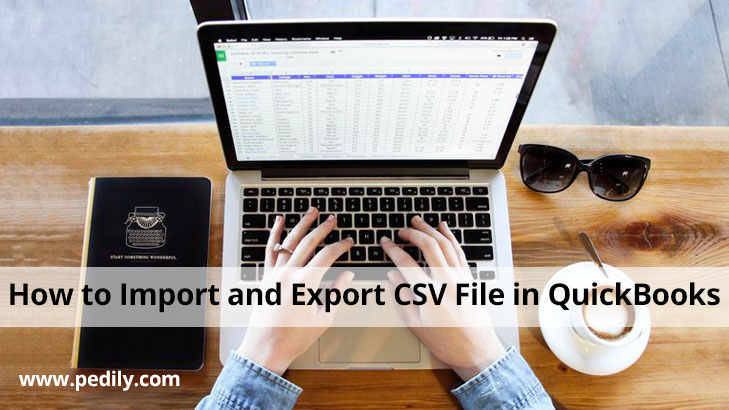Last Updated on February 16, 2021 by
QuickBooks Desktop lets you import or export data. Instead of starting from scratch, you can transfer information from QuickBooks in case you need to change, upgrade, or create a QuickBooks company file. Before you start importing or exporting data, you want to know the transaction type and file format to ensure that QuickBooks can handle them. Each field of the file is separated from the next by a comma. Most spreadsheets support this format, although you can create and edit CSV files with any text editor such as Notepad.
You can associate your financial balance and Mastercard record to QuickBooks to consequently import exchanges. In the event that you have to go further back, you can physically download CSV records of exchanges from your bank and afterward transfer documents for CSV import into your bookkeeping programming. CSV records are straightforward content documents containing plain information. So, here you can learn how to import and export CSV files in QuickBooks Desktop.
To Import and Export CSV file in QuickBooks
First, we will tell you how to import then we will move to the steps for how to export CSV files in QuickBooks. Typically, QuickBooks allows you to import or export lists from MS Excel. You can import some transactions like online web connect files of your bank and you can export all reports as Excel or PDF files. So let’s move to the various steps that are involved to import and export CSV files in QuickBooks.
Import CSV File in QuickBooks
In your business, there may come a period that you should redesign, change over, or make another CSV record. QuickBooks CSV import will definitely useful at that point. CSV in full terms implies Comma-Separated Values. CSV documents are very straightforward content records that will in general contain even information. In this manner, the fields in any record have commas in the middle to isolate them.
This toolbox contains a few things like CSV and XLS models organizer, permitted fields, and Import structure Excel and CSV manual. The XLS model organizer has a solitary Excel record with four worksheets speaking to each rundown type. The permitted fields are a reference control that clarifies the accessible fields for CSV and Excel import. The import from CSV and Excel manual is regularly a PDF record that has guidelines, notes, and best practices. To import the list in CSV format, you need to install QuickBooks Import Excel and CSV Toolkit. The toolkit contains:
- Import from Excel and CSV manual – It contains a PDF document with instructions, best practices, and notes.
- CSV example folder – 4 sample CSV files for each type of list.
- XLS example folder – an example Excel file containing 4 worksheets, one for each type of list.
- Allowed fields – A reference guide explaining which fields are available for Excel and CSV import.
Steps to Install QuickBooks Import Excel and CSV Toolkit
- First, you have to open the file download window for the toolkit, and then you have to click on Save.
- Go to your Windows desktop, then choose Save.
- You need to double-click on the QuickBooks_Import_Excel_and_CSV.exe option on your system for opening the WinZip Self-Extractor window.
- Select Browse, select the folder where you want to install the toolkit (such as your desktop), then OK.
- Select Unzip to remove the content, and then click Close to close the WinZip Self-Extractor window.
- Open the QuickBooks Import Excel and CSV folder from the location you chose.
How to Import CSV File in QuickBooks
When you are ready with downloading and installing QuickBooks Import Excel and CSV Toolkit, you can easily proceed to the QuickBooks CSV import process. The below step is the best procedure for QuickBooks import CSV:
- From the left menu tab, go to the ‘Banking section.
- Now chose the option of ‘Update drop-down’ or ‘Upload transactions manually’.
- Then hit on the ‘File to upload’/ ‘File Upload’.
- Go to the ‘Browse’ to choose the .CSV file that has been saved.
- Click on the ‘Next’.
- From the QuickBooks account section, hit on the account to import
- Then again click ‘Next’.
- According to your .CSV file’s format, map the fields.
- Again hit ‘Next’.
- Choose the CSV files to import.
- Click on ‘Next’.
- Hit on the ‘Yes’ button to the number given in the notification
- Then hit the ‘Finish’ option once you receive confirmation of the import.
- Now from the Downloaded Transactions window, you can see the transactions imported from CSV files./li>
Export CSV File in QuickBooks
You can export customer data, for example, customer notes, shared archives, colleague information, ventures, and errands, from Your Practice. You can likewise export information from Your Books. CSV records are straightforward content documents containing even information. And every field in the record is isolated from the following by a comma. Most spreadsheets bolster this arrangement, in spite of the fact that you can make and alter CSV documents with any content manager like Notepad.
You can trade a rundown as a CSV record in the event that you don’t have MS Excel introduced on your PC or in the event that you need to see and alter your information utilizing an alternate organization.If you do not install MS Excel on your computer or if you want to view and edit your data using a different format then you can export the list as a CSV file.
Customer and Supplier
- Open Customer / Supplier Center.
- Then you have to click on the Excel drop-down, and then choose:
- Now if you want to export customer/supplier data such as name, balance, and contact information, then you need to export the customer/supplier list.
- But if you want to export the transaction (by name or transaction type), then you have to do the export transaction.
- Now you have to go to the Export window, and from there you need to choose to create a comma-separated value (.csv) file.
- In this step, you have to click on Export.
- Assign the file name, then choose the location where you want to save the file.
- Open, open, and edit the file as required.
Item
- Go to the list menu, then choose the item list.
- Choose the Excel drop-down and then choose Export All Items.
- Now you have to go to the Export window, and from there you need to choose to create a comma-separated value (.csv) file.
- In this step, you have to click on Export.
- Assign the file name, then choose the location where you want to save the file.
- Open, open, and edit the file as required.
Report
- Firstly, you have to open the report.
- After that, you need to choose the Excel drop-down which is present at the top of the report.
- Then you have to create a new worksheet.
- Now you have to go to Send Report to Excel window, and from there you need to choose to create a comma-separated value (.csv) file.
- In this step, you have to click on Export.
- Now you need to assign the file name, and then choose the location where you want to save the file.
- At last, you have to open and edit the file as required.
Conclusion
This blog helps you to Import and Export CSV file in QuickBooks. We hope all information is useful for all QuickBooks users. If the problem to understand all steps you have one more option you can contact QuickBooks Expert ProAdvisor and solves your problem in a simple way without wasting your time.

